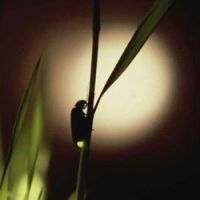It seems no one really knows why the two predominant varieties of hotaru (firefly) in Japan are known as genji-botaru and heike-botaru.
Perhaps it is a purely literary thing — with the larger (and brighter) genji variety (Luciola cruciata) named after the character from the 11th-century novel "The Tale of Genji" by Murasaki Shikibu, and the smaller heike variety (Luciola lateralis) named after the almost-as-famous 14th-century "The Tale of Heike."
On the other hand, it may be that the names are military references, with the descriptor "genji" awarded to the larger bug because it was the Genji clan who defeated the Heike clan in the 12th-century Genpei Wars. The fact that the fighting ended around early summer gives this explanation credence, because in Japan, early summer is firefly season.
Despite the warlike nature of their possible namesakes, the genji and heike fireflies are delicate creatures. Their larvae need clean rivers or rice paddies with mineral-rich water to grow, meaning the chances to enjoy their delightful glow in urban environments are rare.
Still, that hasn't stopped generations of Japan's city-dwellers from romanticizing the insects and, in recent years, even engineering events in which they can be seen in the capital's concrete jungle.
Tokyo's Itabashi Hotaru Breeding Facility, near Shintakashimadaira Station on the Mita subway line, is dedicated to the insects' breeding and study.
Usually the facility is open to the public during the day, with exhibits explaining how enzymes in the insects' lower abdomens react to generate light. But to celebrate hotaru season, when the larvae emerge from their watery homes as fireflies, they are put in a glasshouse and visitors are allowed to see them in the evening.
According to the facility's Web site, 7,700 genji-botaru will be on display between 7:30 and 9:30 p.m. from June 20 to 22. And from July 19 to 21, about 14,300 heike-botaru will be displayed between the same times.
Admission for both events is free. For details call (03) 5970-3426. (Note: between June 16 and July 26, the facility will not be open during the day — presumably to give the fireflies time to rest.)
Meanwhile, for those wishing to see hotaru in the "wild," a group of citizens in Tokyo's Fussa City spend weeks each year breeding genji-botaru, which they release around Hotaru Koen and Tamagawa Josui at Omebashi Bridge.
This year around 500 will be released between June 12 and 22.
The Fussa Hotaru Festival will be held Saturday, June 14, from 1 to 9 p.m. In addition to the sparkling insects, there will be stalls selling food and souvenirs. Call Fussa City at (042) 551-1699 or check the Fussa Web site www.city.fussa.tokyo.jp for details.



